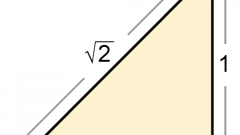You will need
- basic knowledge of trigonometry
Instruction
1
Let's consider a given triangle with sides a, b, and C. the sum of the lengths of any two sides of a triangle must be greater than the length of the third side, i.e. a+b>c, b+c>a and a+c>b. And need to find the degree measure of all angles of this triangle. Let the angle between sides a and b are designated as α, the angle between b and c as β, and the angle between c and a as γ.
2
The theorem of cosines is: square the lengths of sides of a triangle is equal to the sum of the squares of the lengths of the other two sides minus twice the product of these side lengths into the cosine of the angle between them. That is, make up three equations: a2=b2+c2−2×b×c×cos(β); b2=a2+c2−2×a×c×cos(γ); c2=a2+b2−2×a×b×cos(α).
3
From the obtained equations Express the cosines of the angles: cos(β)=(b2+c2−a2)÷(2×b×c); cos(γ)=(a2+c2−b2)÷(2×a×c); cos(α)=(a2+b2−c2)÷(2×a×b). Now we know the cosines of the angles of a triangle to find themselves angles use the tables Bradis or take from these expressions arccosine: β=arccos(cos(β)); γ=arccos(cos(γ)]; α=arccos(cos(α)).
4
For example, let a=3, b=7, c=6. Then cos(α)=(32+72-62)÷(2×3×7)=11/21 and α≈58,4°; cos(β)=(72+62-32)÷(2×7×6)=19/21 and β≈25,2°; cos(γ)=(32+62-72)÷(2×3×6)=-1/9 and γ≈96,4°.
5
This task can be solved in another way via the area of the triangle. First, find properiter triangle according to the formula p=(a+b+c)÷2. Then calculate the area of a triangle by Heron's formula S=√(p×(p−a)×(p−b)×(p−c)), that is, the area of a triangle is equal to the square root of the product of properiety triangle and the differences of properiety and each of the sides of the triangle.
6
On the other hand, the area of a triangle equals half the product of the lengths of two sides the sine of the angle between them. It turns out S=0,5×a×b×sin(α)=0,5×b×c×sin(β)=0,5×a×c×sin(γ). Now from this formula we Express the sines of the angles and the substitute was obtained in 5 steps value of the area of a triangle: sin(α)=2×S÷(a×b); sin(β)=2×S÷(b×c); sin(γ)=2×S÷(a×c). Thus, knowing the sines of the angles to find the degree measure use the table Bradis or count arctinus these expressions: β=arccsin(sin(β)); γ=arcsin(sin(γ)]; α=arcsin(sin(α)).
7
For example, suppose that we are given the same triangle with sides a=3, b=7, c=6. Properiter is p=(3+7+6)÷2=8, area S=√(8×(8-3)×(8-7)×(8-6))=4√5. Then sin(α)=2×4√5÷(3×7)=8√5/21 and α≈58,4°; sin(β)=2×4√5÷(7×6)=4√5/21 and β≈25,2°; sin(γ)=2×4√5÷(3×6)=4√5/9 and γ≈96,4°.
Useful advice
The sum of the angles of a triangle always equal 180 degrees. Therefore, we can only compute two corners of the triangle, and the third is obtained by subtracting from 180 the sum of these two angles.








